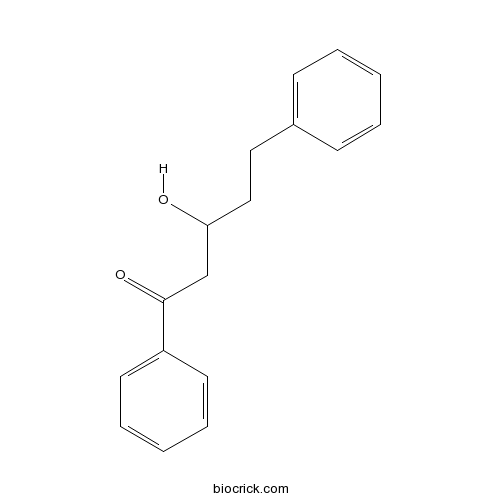3-Hydroxy-1,5-diphenyl-1-pentanoneCAS# 60669-64-9 |

- (S)-3-Hydroxy-1,5-diphenylpentan-1-one
Catalog No.:BCX0187
CAS No.:163086-00-8
Quality Control & MSDS
3D structure
Package In Stock
Number of papers citing our products

| Cas No. | 60669-64-9 | SDF | Download SDF |
| PubChem ID | 11021438 | Appearance | Powder |
| Formula | C17H18O2 | M.Wt | 254.3 |
| Type of Compound | Phenols | Storage | Desiccate at -20°C |
| Solubility | Soluble in Chloroform,Dichloromethane,Ethyl Acetate,DMSO,Acetone,etc. | ||
| Chemical Name | 3-hydroxy-1,5-diphenylpentan-1-one | ||
| SMILES | C1=CC=C(C=C1)CCC(CC(=O)C2=CC=CC=C2)O | ||
| Standard InChIKey | QJUWGGININGVSC-UHFFFAOYSA-N | ||
| General tips | For obtaining a higher solubility , please warm the tube at 37 ℃ and shake it in the ultrasonic bath for a while.Stock solution can be stored below -20℃ for several months. We recommend that you prepare and use the solution on the same day. However, if the test schedule requires, the stock solutions can be prepared in advance, and the stock solution must be sealed and stored below -20℃. In general, the stock solution can be kept for several months. Before use, we recommend that you leave the vial at room temperature for at least an hour before opening it. |
||
| About Packaging | 1. The packaging of the product may be reversed during transportation, cause the high purity compounds to adhere to the neck or cap of the vial.Take the vail out of its packaging and shake gently until the compounds fall to the bottom of the vial. 2. For liquid products, please centrifuge at 500xg to gather the liquid to the bottom of the vial. 3. Try to avoid loss or contamination during the experiment. |
||
| Shipping Condition | Packaging according to customer requirements(5mg, 10mg, 20mg and more). Ship via FedEx, DHL, UPS, EMS or other couriers with RT, or blue ice upon request. | ||
| Description | 1. (+)-3-Hydroxy-1,5-diphenyl-1-pentanone exhibits both immunomodulatory and anti-tumor activity. |
| Targets | Immunology & Inflammation related |

3-Hydroxy-1,5-diphenyl-1-pentanone Dilution Calculator

3-Hydroxy-1,5-diphenyl-1-pentanone Molarity Calculator
| 1 mg | 5 mg | 10 mg | 20 mg | 25 mg | |
| 1 mM | 3.9324 mL | 19.6618 mL | 39.3236 mL | 78.6473 mL | 98.3091 mL |
| 5 mM | 0.7865 mL | 3.9324 mL | 7.8647 mL | 15.7295 mL | 19.6618 mL |
| 10 mM | 0.3932 mL | 1.9662 mL | 3.9324 mL | 7.8647 mL | 9.8309 mL |
| 50 mM | 0.0786 mL | 0.3932 mL | 0.7865 mL | 1.5729 mL | 1.9662 mL |
| 100 mM | 0.0393 mL | 0.1966 mL | 0.3932 mL | 0.7865 mL | 0.9831 mL |
| * Note: If you are in the process of experiment, it's necessary to make the dilution ratios of the samples. The dilution data above is only for reference. Normally, it's can get a better solubility within lower of Concentrations. | |||||

Calcutta University

University of Minnesota

University of Maryland School of Medicine

University of Illinois at Chicago

The Ohio State University

University of Zurich

Harvard University

Colorado State University

Auburn University

Yale University

Worcester Polytechnic Institute

Washington State University

Stanford University

University of Leipzig

Universidade da Beira Interior

The Institute of Cancer Research

Heidelberg University

University of Amsterdam

University of Auckland

TsingHua University

The University of Michigan

Miami University

DRURY University

Jilin University

Fudan University

Wuhan University

Sun Yat-sen University

Universite de Paris

Deemed University

Auckland University

The University of Tokyo

Korea University
- Isopicropodophyllone
Catalog No.:BCN8316
CAS No.:60660-50-6
- HOSu
Catalog No.:BCC2845
CAS No.:6066-82-6
- 3-n-Butylphthalide
Catalog No.:BCN2381
CAS No.:6066-49-5
- Dihydromollugin
Catalog No.:BCN8247
CAS No.:60657-93-4
- Danaidone
Catalog No.:BCN1966
CAS No.:6064-85-3
- Bifonazole
Catalog No.:BCC4766
CAS No.:60628-96-8
- MEK162 (ARRY-162, ARRY-438162)
Catalog No.:BCC1148
CAS No.:606143-89-9
- AZD6244 (Selumetinib)
Catalog No.:BCC3624
CAS No.:606143-52-6
- Momor-cerebroside I
Catalog No.:BCN4120
CAS No.:606125-07-9
- MK-0773
Catalog No.:BCC1754
CAS No.:606101-58-0
- Homopterocarpin
Catalog No.:BCN4615
CAS No.:606-91-7
- Cinnabarinic acid
Catalog No.:BCC7865
CAS No.:606-59-7
- FC 131
Catalog No.:BCC7917
CAS No.:606968-52-9
- Sesamin
Catalog No.:BCN4123
CAS No.:607-80-7
- Myristicin
Catalog No.:BCN2730
CAS No.:607-91-0
- Physoperuvine
Catalog No.:BCN1402
CAS No.:60723-27-5
- SB 772077B dihydrochloride
Catalog No.:BCC6116
CAS No.:607373-46-6
- AZ 10606120 dihydrochloride
Catalog No.:BCC6005
CAS No.:607378-18-7
- Canthin-6-one N-oxide
Catalog No.:BCN2992
CAS No.:60755-87-5
- 2-Hydroxy-1,8-cineole
Catalog No.:BCN4121
CAS No.:60761-00-4
- ent-Kauran-17,19-dioic acid
Catalog No.:BCN4122
CAS No.:60761-79-7
- Meloside A
Catalog No.:BCN2278
CAS No.:60767-80-8
- Ethyl 4-methoxysalicylate
Catalog No.:BCN3499
CAS No.:35031-00-6
- A 77-01
Catalog No.:BCC1318
CAS No.:607737-87-1
A new bicoumarin from Stellera chamaejasme L.[Pubmed:11783587]
J Asian Nat Prod Res. 2001;3(4):335-40.
Thirteen compounds were isolated from roots of Stellera chamaejasme L. (Thymelaeaceae). They are 3-sitosterol (2), simplexin (3), pimelea factor P2 (4), daucosterol (5), (+)-3-Hydroxy-1,5-diphenyl-1-pentanone (6), 4-ethoxy-benzoic acid (7), 2,4,6-Trimethoxy-benzoic acid (8), (+)-afzelechin (9), fumaric acid (10), N,N-dimethyl-L-aspartic acid (11), umbelliferone (12), daphniretin (13) and a novel bicoumarin named bicoumastechamin (1). Among the known compounds, 7, 8, 9, 10 and 11 were first isolated from this plant, and 6 was first isolated from the natural resources. Their structures have been elucidated on the basis of spectral data. In vitro bioassays showed that 4 inhibited cancer cell growth, 13 exhibited immunomodulatory activity, and 6 exhibited both immunomodulatory and anti-tumor activity.
Oleodaphnoic acid and coriaceol, two new natural products from the stem bark of Wikstroemia coriacea.[Pubmed:23462531]
Molecules. 2013 Mar 5;18(3):2988-96.
Fractionation of the chloroform extract of Wikstroemia coriacea led to the isolation of two new compounds, oleodaphnoic acid (1), a guaiane-type sesquiterpenoid, and coriaceol (2), an 1,5-diphenyl-1-pentanone analogue, together with nine known compounds. The structures of 1 and 2 were elucidated by extensive spectroscopic data analysis. The known compounds were oleodaphnal (3), indicanone (4), (5R,8R,8aR)-3,8-dimethyl-4,5,6,7,8,8a-hexahydro-5-(1-methylethenyl)-2(1H)-azuleno ne, (5), 1,5 diphenyl-1-pentanone (6), (+)-3-Hydroxy-1,5-diphenyl-1-pentanone (7), umbelliferone (8), daphnoretin (9), beta-sitostenone (10) and (-)-hinokinin (11).


